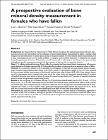| dc.contributor.author | Kenny, Rose | |
| dc.date.accessioned | 2019-08-22T08:13:28Z | |
| dc.date.available | 2019-08-22T08:13:28Z | |
| dc.date.issued | 2003 | |
| dc.date.submitted | 2003 | en |
| dc.identifier.citation | Newton J.L., Kenny R.A., Frearson R., Francis R.M. A prospective evaluation of bone mineral density measurement in females who have fallen, Age and Ageing, 2003, 32, 5, 497-502 | en |
| dc.identifier.other | Y | |
| dc.identifier.other | doi: https://doi.org/10.1093/ageing/afg062 | |
| dc.identifier.uri | https://academic.oup.com/ageing/article/32/5/497/21397 | |
| dc.identifier.uri | http://hdl.handle.net/2262/89281 | |
| dc.description | PUBLISHED | en |
| dc.description.abstract | Background: the National Service Framework for Older Persons recognises the relationship between falls and osteoporosis; however, the best method for the evaluation of bone mineral density measurement in fallers is unclear. Dual energy X-ray absorptiometry of lumbar spine and hip is the gold standard for bone mineral density measurement, but is time consuming and may not be readily available. A cheaper, more portable alternative is peripheral dual energy X-ray absorptiometry of the heel. This predicts overall fracture risk as effectively as dual X-ray at the spine and hip,although site speciWc measurements provide the best estimate of fracture risk at a particular location. Aims: 1. To validate peripheral dual energy X-ray in fallers by comparing heel bone mineral density measurement with measurements obtained at the lumbar spine and hip. 2. To determine the prevalence of osteoporosis in an unselected cohort of fallers. Methods: 118 consecutive females over 50 attending for investigation of falls had heel bone mineral density measurement measured using peripheral dual energy X-ray (PIXI, Lunar). A representative sample of 52 (44%) also attended for bone mineral density measurement at the hip and lumbar spine using Hologic QDR 4500. Bone mineral density (g/cm2) measurements were compared with mean values for young adults and age-related normals giving T (number of standard deviation units above or below the mean for normal young adults) and Z (number of standard deviations above or below the age-related normal mean) scores. Results: in the total group [n= 118 mean (SD) age 74 (11)] heel bone mineral density was 0.4 (0.1), T score −1.1 (1.6)and Z score −0.1 (1.5). The relationship between absolute bone mineral density measurements taken at heel, total hip and lumbar spine were compared and the correlation coefficients show a strong positive relationship between all measurements (all r values > 0.54, P< 0.0001) with a particularly strong relationship between hip and heel (r = 0.74). Those with two or more risk factors for falls were significantly more likely to have lower bone mineral density. Discussion: this study has shown that peripheral dual energy X-ray is a reliable method of assessment, applicable to use within a Falls Unit. In addition, although the prevalence of osteoporosis is not increased in unselected fallers, those with two or more risk factors for falls are at increased risk of osteoporosis and limited resources may be more appropriately targeted toward this group. | en |
| dc.format.extent | 497 | en |
| dc.format.extent | 502 | en |
| dc.language.iso | en | en |
| dc.relation.ispartofseries | AGE AND AGEING; | |
| dc.relation.ispartofseries | 32; | |
| dc.relation.ispartofseries | 5; | |
| dc.rights | Y | en |
| dc.subject | Older people | en |
| dc.subject | Falls | en |
| dc.subject | Fractures | en |
| dc.subject | Osteoporosis | en |
| dc.title | A prospective evaluation of bone mineral density measurement in females who have fallen | en |
| dc.type | Journal Article | en |
| dc.type.supercollection | scholarly_publications | en |
| dc.type.supercollection | refereed_publications | en |
| dc.identifier.peoplefinderurl | http://people.tcd.ie/rkenny | |
| dc.identifier.rssinternalid | 39478 | |
| dc.rights.ecaccessrights | openAccess | |
| dc.subject.TCDTheme | Ageing | en |




